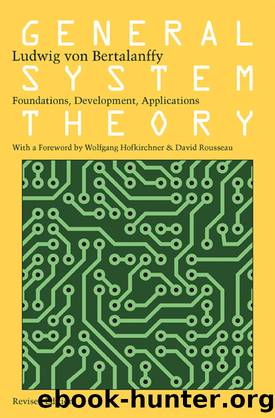General System Theory by Ludwig von Bertalanffy

Author:Ludwig von Bertalanffy
Language: eng
Format: epub
Publisher: George Braziller
6 The Model of Open System
The Living Machine and Its Limitations
The present discussion may be started with one of those trivial questions which are often only too difficult to answer scientifically. What is the difference between a normal, a sick and a dead organism? From the standpoint of physics and chemistry the answer is bound to be that the difference is not definable on the basis of so-called mechanistic theory. Speaking in terms of physics and chemistry, a living organism is an aggregate of a great number of processes which, sufficient work and knowledge presupposed, can be defined by means of chemical formulas, mathematical equations, and laws of nature. These processes, it is true, are different in a living, sick or dead dog; but the laws of physics do not tell a difference, they are not interested in whether dogs are alive or dead. This remains the same even if we take into consideration the latest results of molecular biology. One DNA molecule, protein, enzyme or hormonal process is as good as another; each is determined by physical and chemical laws, none is better, healthier or more normal than the other.
Nevertheless, there is a fundamental difference between a live and a dead organism; usually, we do not have any difficulty in distinguishing between a living organism and a dead object. In a living being innumerable chemical and physical processes are so “ordered” as to allow the living system to persist, to grow, to develop, to reproduce, etc. What, however, does this notion of “order” mean, for which we would look in vain in a textbook of physics? In order to define and explain it we need a model, a conceptual construct. One such model was used since the beginnings of modern science. This was the model of the living machine. Depending on the state of the art, the model found different interpretations. When, in the seventeenth century, Descartes introduced the concept of the animal as a machine, only mechanical machines existed. Hence the animal was a complicated clockwork. Borelli, Harvey and other so-called iatrophysicists explained the functions of muscles, of the heart, etc., by mechanical principles of levers, pumps and the like. One can still see this in the opera, when in the Tales of Hoffmann the beautiful Olympia turns out to be an artfully constructed doll, an automaton as it was called at the time. Later, the steam engine and thermodynamics were introduced, which led to the organism being conceived as a heat engine, a notion which lead to caloric calculations and other things. However, the organism is not a heat engine, transforming the energy of fuel into heat and then into mechanical energy. Rather it is a chemodynamic machine, directly transforming the energy of fuel into effective work, a fact on which, for example, the theory of muscle action is based. Lately, self-regulating machines came to the fore, such as thermostats, missiles aiming at a target and the servomechanisms of modern technology. So the organism became a cybernetic machine, explanatory of many homeostatic and related phenomena.
Download
This site does not store any files on its server. We only index and link to content provided by other sites. Please contact the content providers to delete copyright contents if any and email us, we'll remove relevant links or contents immediately.
Time Management Made Easy: How to Cultivate New Habits, Improve Productivity and Get Things Done by Joshua Strachan(2374)
The 7 Habits of Highly Effective People by Stephen R. Covey & Sean Covey(2173)
The Concise Laws of Human Nature by Robert Greene(1754)
Doesn't Hurt to Ask by Trey Gowdy(1575)
Primal Leadership by Daniel Goleman(1168)
Hook Point: How to Stand Out in a 3-Second World by Brendan Kane(1115)
HBR's 10 Must Reads 2021 by unknow(1055)
Don't Sweat the Small Stuff...and It's All Small Stuff by Richard Carlson(1043)
Amazon Unbound by Brad Stone(991)
100 Things Successful People Do by Nigel Cumberland(975)
HBR's 10 Must Reads 2021 by Harvard Business Review(964)
The Job Closer by Steve Dalton(950)
Master of One by Jordan Raynor(947)
Lives of the Stoics by Ryan Holiday & Stephen Hanselman(910)
Declutter Your Mind: A step by step guide to learn to control your thoughts, stop worrying, relieve anxiety and eliminate panic attacks and negative thinking by Mia Chandler(901)
The Power of 100! by Shaun King(886)
Conflicted by Ian Leslie(812)
Coders at Work: Reflections on the craft of programming by Peter Seibel(800)
The Book of Hope by Jane Goodall(770)
